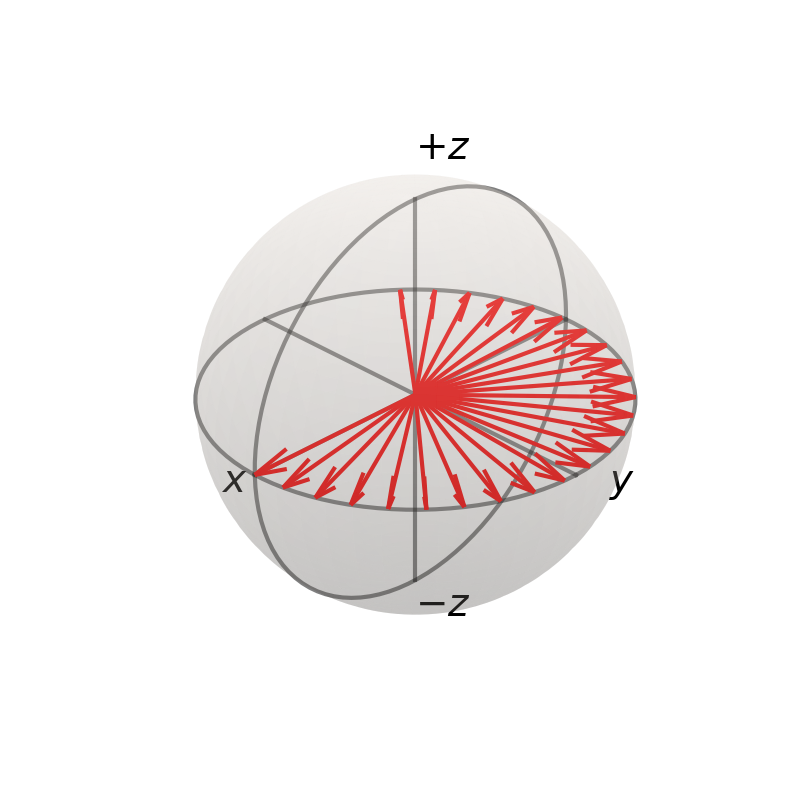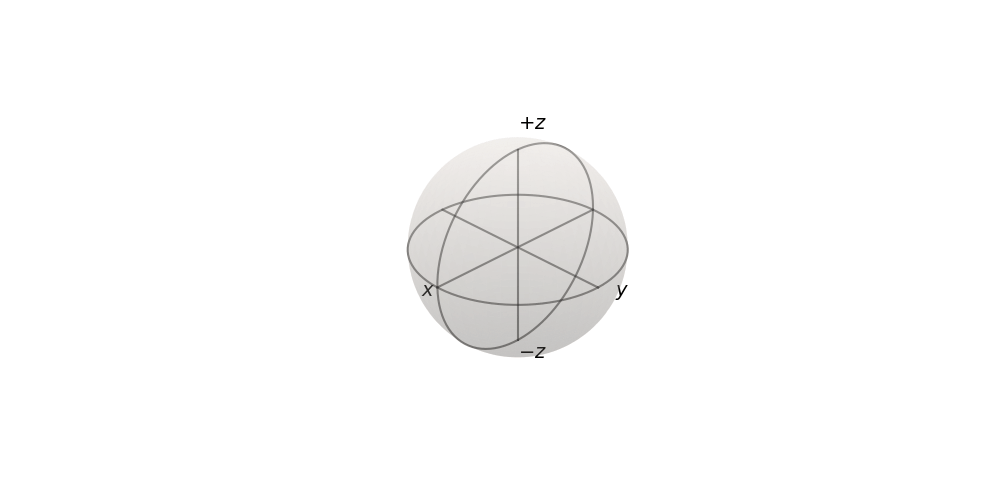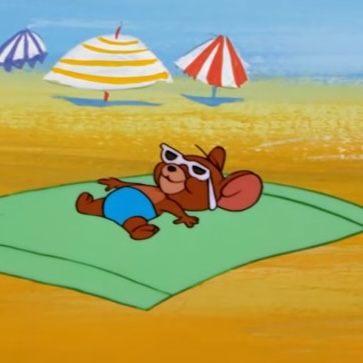Bloch sphere plots and animations
I’ll show how to plot the Bloch sphere in Python using Matplotlib. Then, I will show how to make basic animations.
Here are the final results


You can find all the code on my GitHub, run the file on Google Colab, or copy snipped of code below.
Bloch sphere setup
 We can import the standard visualisation packages and customise them for aesthetics.
We can import the standard visualisation packages and customise them for aesthetics.
%config InlineBackend.figure_format = "retina"
%matplotlib inline
import matplotlib
import matplotlib.pyplot as plt
from mpl_toolkits.mplot3d import Axes3D
from matplotlib import animation
from matplotlib import rcParams
rcParams["savefig.dpi"] = 100
rcParams["figure.figsize"] = [10, 5]
rcParams["figure.dpi"] = 100
rcParams["font.size"] = 14
import numpy as npAnd now we set-up the blank canvas for a Bloch sphere
fig = plt.figure()
ax = fig.add_subplot(111, projection='3d')
ax.set_aspect("equal")
# Make data
r = 1
u = np.linspace(0, 2 * np.pi, 100)
v = np.linspace(0, np.pi, 100)
x = r * np.outer(np.cos(u), np.sin(v))
y = r * np.outer(np.sin(u), np.sin(v))
z = r * np.outer(np.ones(np.size(u)), np.cos(v))
# Plot the surface
ax.plot_surface(x, y, z, color='linen', alpha=0.2)
# plot circular curves over the surface
theta = np.linspace(0, 2 * np.pi, 100)
z = np.zeros(100)
x = r * np.sin(theta)
y = r * np.cos(theta)
ax.plot(x, y, z, color='black', alpha=0.50)
ax.plot(y, z, x, color='black', alpha=0.50)
## add axis lines
zeros = np.zeros(1000)
line = np.linspace(-r,r,1000)
ax.plot(line, zeros, zeros, color='black', alpha=0.50)
ax.plot(zeros, line, zeros, color='black', alpha=0.50)
ax.plot(zeros, zeros, line, color='black', alpha=0.50)
# draw a point
eps = 0.2
ax.text(1+eps,0,0,'$x$')
ax.text(0,1+eps,0,'$y$')
ax.text(0,0,1+eps,'$+z$')
ax.text(0,0,-1-eps,'$-z$')
ax.set_xlim3d(-1,1)
ax.set_ylim3d(-1,1)
ax.set_zlim3d(-1,1)
ax.set_axis_off()
ax.azim = 45
plt.show()I like to wrap this code into a function that can be used repeatedly.
# Sets up the fig and ax for a Bloch sphere
def bloch_sphere():
fig = plt.figure()
ax = fig.add_subplot(111, projection='3d')
ax.set_aspect("equal")
# Make data
r = 1
u = np.linspace(0, 2 * np.pi, 100)
v = np.linspace(0, np.pi, 100)
x = r * np.outer(np.cos(u), np.sin(v))
y = r * np.outer(np.sin(u), np.sin(v))
z = r * np.outer(np.ones(np.size(u)), np.cos(v))
# Plot the surface
ax.plot_surface(x, y, z, color='linen', alpha=0.2)
# plot circular curves over the surface
theta = np.linspace(0, 2 * np.pi, 100)
z = np.zeros(100)
x = r * np.sin(theta)
y = r * np.cos(theta)
ax.plot(x, y, z, color='black', alpha=0.50)
ax.plot(y, z, x, color='black', alpha=0.50)
## add axis lines
zeros = np.zeros(1000)
line = np.linspace(-r,r,1000)
ax.plot(line, zeros, zeros, color='black', alpha=0.50)
ax.plot(zeros, line, zeros, color='black', alpha=0.50)
ax.plot(zeros, zeros, line, color='black', alpha=0.50)
# draw a point
eps = 0.2
ax.text(1+eps,0,0,'$x$')
ax.text(0,1+eps,0,'$y$')
ax.text(0,0,1+eps,'$+z$')
ax.text(0,0,-1-eps,'$-z$')
ax.set_xlim3d(-1,1)
ax.set_ylim3d(-1,1)
ax.set_zlim3d(-1,1)
ax.set_axis_off()
ax.azim = 45
return fig, axDrawing vectors
 Now I can start adding vectors to it
Now I can start adding vectors to it
# Let's draw some vectors
fig, ax = bloch_sphere()
N = 25 #number of arrows
thetas = np.linspace(0, 4, N) # parameterising the arrows
# heads of the arrows with adjusted arrow head length
bvecs = []
for i in range(len(thetas)):
bvecs.append([np.cos(thetas[i]), np.sin(thetas[i]), 0])
bvecs = np.array(bvecs)
# tails of the arrows
tails= np.zeros(N)
ax.quiver(tails,tails,tails,bvecs[:,0], bvecs[:,1], bvecs[:,2], length=1.0, normalize=True, color='r', arrow_length_ratio=0.2)
plt.show()Animating vectors

# Let's animate this
fig, ax = bloch_sphere()
N = 25 #number of arrows
thetas = np.linspace(0, 4, N) # parameterising the arrows
# heads of the arrows with adjusted arrow head length
bvecs = []
for i in range(len(thetas)):
bvecs.append([np.cos(thetas[i]), np.sin(thetas[i]), 0])
bvecs = np.array(bvecs)
# tails of the arrows
tails= np.zeros(N)
def update(num):
ax.quiver(tails[:num],tails[:num],tails[:num],bvecs[:num,0], bvecs[:num,1], bvecs[:num,2],
length=1.0, normalize=True, color='r', arrow_length_ratio=0.2)
ani = animation.FuncAnimation(fig, update, N, interval=1000/N, blit=False)
ani.save('my_animation.gif')
plt.show()Drawing points

# Let's draw some points
fig, ax = bloch_sphere()
N = 10 # number of points
thetas = np.linspace(0, 4, N)
# points on bloch sphere
points = []
for i in range(len(thetas)):
points.append([np.cos(thetas[i]), np.sin(thetas[i]), 0])
points = np.array(points)
ax.scatter(points[:, 0], points[:, 1], points[:, 2], color='r')
plt.show()Animating points

# Let's animate the points
fig, ax = bloch_sphere()
N = 10 # number of points
thetas = np.linspace(0, 4, N)
# points on bloch sphere
points = []
for i in range(len(thetas)):
points.append([np.cos(thetas[i]), np.sin(thetas[i]), 0])
points = np.array(points)
def update(num):
ax.scatter(points[:num, 0], points[:num, 1], points[:num, 2], color='r')
ani = animation.FuncAnimation(fig, update, N, interval=1000/N, blit=False)
ani.save('my_animation2.gif')
plt.show()